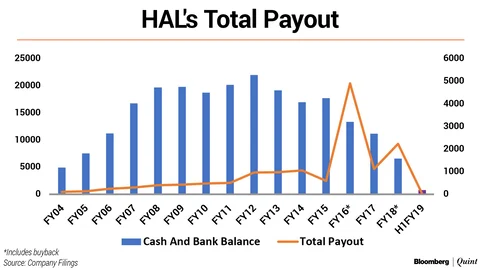EXPLAINER: Why HAL’s Cash Crunch Worsened

Hindustan Aeronautics Ltd. is battling a crippling financial crunch. That’s because pending payments from the government, it’s largest client, ballooned even as the dividend payout to the government, also its largest shareholder, doubled since financial year 2012-13.
Cash balance of HAL depleted to its lowest in 16 years as of September 2018, show the exchange filings of the state-owned maker of fighter jets. The receivables—or payments from clients—jumped to their highest since 2012.
That forced the aerospace equipment maker to take an overdraft facility from banks to meet its current cash needs. The cash crunch comes when the opposition parties are embroiled in a dogfight with the government for overlooking HAL as a partner for the deal to buy Rafale jets from France’s Dassault Aviation in favour of Anil Ambani’s Reliance Group. The controversy refused to die down even after the Supreme Court found nothing wrong with the approval process.
Receivables Fall, Then Double
Despite reporting profits, HAL has had a negative cash flow from operations in the last two financial years – which suggests that more money is flowing out of the business rather than coming in. One of the main reasons is rising trade receivables.
HAL’s pending payments from its clients more than doubled since March 2017 to Rs 9,845 crore as of September 2018. These payments will be mostly due from the government as HAL gets more than 90 percent of its revenue from Indian Army.
That led to the cash crunch.
This will only start hurting the company if they fail to receive timely payments from their operational debtor [in this case the government], Sameer Kalra, founder of Target Investing, told BloombergQuint. “That will stretch its liquidity position.”
Multiple media reports said HAL borrowed funds to pay salaries. HAL tweeted that it took a short-term loan of Rs 962 crore without giving reasons. The public sector company has yet to respond to BloombergQuint’s queries.
Yet, the loan is not an anomaly. HAL has borrowed short-term debt for working capital needs several times at least in the last 20 months as receivables rose.
Due to the negative cash flow, the state-run company borrowed as much as Rs 4,447 crore from banks and financial institutions in the last financial year 2017-18, according to its filings. It repaid close to Rs 3,800 crore of that.
Dividend Payouts

The cash shortage may force HAL to miss out on a dividend payment in financial year 2019—the first time in four decades.
Still, its average payout of close to Rs 2,200 crore in the last four years is more than twice of what it paid in the previous five years. Nearly all of that money went to the government which fully owned HAL till March 2018. After going public in March 2018, the government now holds 90 percent in the company.
HAL paid its biggest dividend in FY18. The company also announced a buyback of close to Rs 922 crore before its initial public offering. Still, its highest-ever total payout to the government came in 2016, when it not only announced a dividend of Rs 614 crore but also a buyback of Rs 4,284 crore.
Why HAL’s Cash Crunch Worsened
Still, the public sector company remains optimistic, hoping that its cash position will improve as it gets pending payments from the government.
HAL’s revenue outlook looks positive at least for the next three years with an order book of more than Rs 60,000 crore, according to the company. About Rs 73,000 crore worth of fresh orders from Indian Air Force are currently at technical evaluation stage, according to a document released by Defence Minister Nirmala Sitharaman.



No comments:
Post a Comment